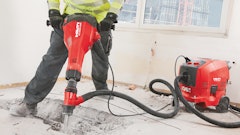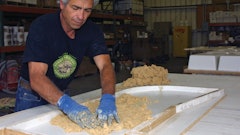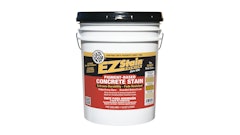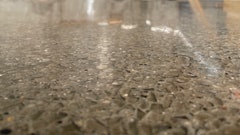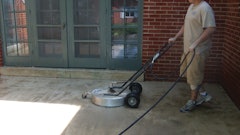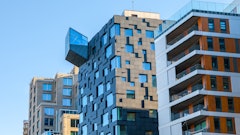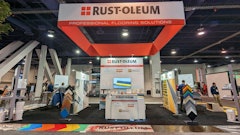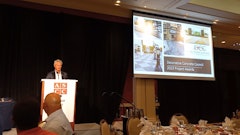After you polish the concrete, and high-speed burnish the stain protector, and the customer looks at his reflection in the floor and smiles, and pays you … are you done with the slab?
If you’re a smart contractor, and you care about your reputation, customer satisfaction and the longevity of your business, the answer is No.
The continuing beauty of a polished concrete floor depends on proper maintenance, especially if it is a dyed finish. It’s more than a matter of keeping it clean and bright: it is crucial to preventing color loss.
There are four steps to proper maintenance.
Step 1: Education
Polished concrete is a low-maintenance floor, but owners need to be made aware that it is not a “no-maintenance” floor. The maintenance it needs is simple, but absolutely essential. Failure to maintain it properly can result in failure of the floor finish. Color can be lost, stains and etching agents can damage the surface, and the shine can dull.
Educate the owner about regular maintenance, periodic cleaning and stain protector renewal. Offer the owner an appropriate cleanser; some densifier manufacturers make a cleaner as part of their product line. Offer to inspect the floor at one year or 18 months in, to see how the stain protector is holding up to traffic. Stay in touch — it’s good for your floors and good for your business.
Step 2: Regular maintenance
The overall objective is to remove anything from the floor — in a timely manner — that will stain it or scratch it. Fast spot clean-ups of oily or acidic spills (including many food substances) is one the keys to preventing permanent staining or discoloration of the surface. Stain protector is a thin, breathable layer that only gives a “window of opportunity” to clean up staining or etching substances before they start to do damage. It is recommended to wait no longer than a half an hour for clean-ups. Do not let spills stay in place overnight.
Remove sand, salt and similar debris frequently. Sand, grit and hard salt crystals can scratch the floor finish over time. Large quantities of grit get embedded on the soles of shoes, which turn those shoes into sand paper. Walk-off mats should be placed at entries and exits to minimize debris tracking onto the floor.
Clean the floor at least twice weekly with a damp microfiber mop and potable water (neutral pH).
Step 3: Periodic cleaning
Owners who are used to stripping and waxing vinyl composite tile (VCT) will be glad to change their routines, because polished concrete will save them time and money. No waxing. No stripping.
The right thing for polished slabs is a mild, non-solvent, non-acidic cleanser. Concrete does not like acids. Use of an appropriate cleanser is important. We at AmeriPolish actually designed our cleanser to mate chemically with our stain protector, taking advantage of regular cleaning as a way to extend the life of the protection layer.
Scrubbing machines need to be fitted with non-aggressive tools such as brushes or soft pads. Never use diamond-impregnated pads or other abrasive pads.
The consequences of using the wrong cleanser or the wrong cleaning tool can be severe — it can wash away the color. We’ve believe that many reports about concrete dye “fading” are a mis-reading the evidence. We think that most often, the color gets washed out, or washed deeper into the slab and out of sight. Stain protector is another key to preventing that. If the cleaning process wears away or eats through the stain protector, color may start to migrate, and be lost a little at a time with every cleaning. Moreover, the slab is exposed to rapid staining by spills.
Step 4: Stain protector renewal
Stain protector can be expected to be reliable for a maximum of two years. In high-traffic areas, it may be worn off much sooner. It is designed as a sacrificial layer that must be renewed to maintain both the color and the shine.
A simple test of the condition of the protector layer is to drop water on it. If it immediately soaks in and darkens the concrete, re-application is required.
These very basic maintenance practices are the best protection for the owner’s investment in a concrete floor, and help it fulfill the promise of low-impact, durability and lasting beauty.









